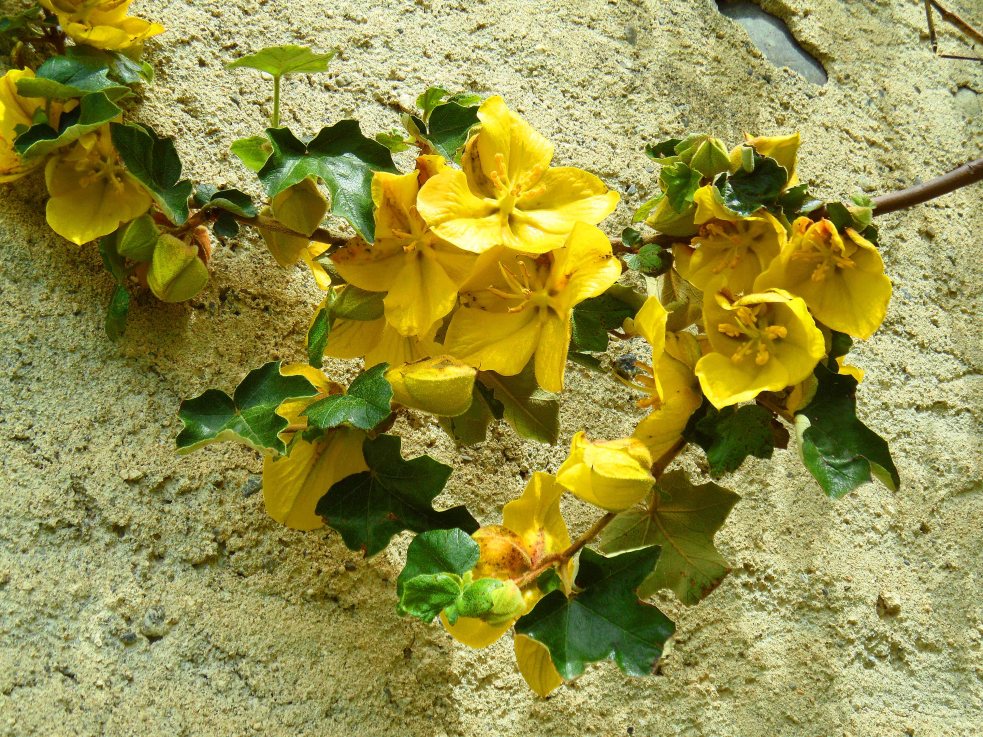I am interrupting my three-part Paris blog to post to you about what is surviving in the garden, and even looking good, despite the fact that we have had no rain for what seems like weeks. It was a dry Spring once we got past the soaking of February, and that theme has continued. Fortunately we have only had a few really warm or hot days, but even so, the accumulated effect is of deeply dried-out soil conditions. Our neighbour, Odette, describes this as ‘a year of nothing’ as her superb vegetable garden buckles under the dryness.
I have, yesterday, resorted to the hosepipe, which I never otherwise use, for two newly planted areas. Desperate times.
So what is surviving? This Caryopteris clandonensis ‘Hint of Gold’ seems to be supremely tough. Last year, the first year in the ground, it hung on through thick and thin, and it is powering over the conditions. However, Leucanthemum ‘Banana Cream’, just peeping out bottom right, has mostly been terminated by the massive slug population.


This little geranium, Geranium himalyense ‘Birch Double’ was mostly wiped out by the dryness last summer, but look, one small plant is holding on. Possibly I did over-reach myself with planting it where I did, but well, sometimes it works.

I love Lychnis, but it is a terrible pest in the self-seeding department. However, here is Lychnis coronaria ‘Gardeners World’ which is sterile, therefore has no seed and the same gorgeous magenta flowers, but double. I suspect that the plants are a little less robust than their more normal cousins, for whom the phrase ‘tough as old boots’ doesn’t even come close, but next year will tell.

This lovely Sanguisorba ‘Cangshan Cranberry’ is really worth buying beyond the lovely name. In it’s third year with me, and now a stately clump, it measures 1.5m across and 1.5m tall, growing in the slightly moister conditions near the banana. This year, and I suspect that this is a sign of some stress, it has developed the slightly odd-looking albino striping on some of the flowers, but the foliage is doing fine for the moment.

This plant is doing fabulously. Introducing Monarda fistulosa, which I started off from seed last year. Monarda has always rotted with me, too much heat and too dry, but this American native came highly recommended for a greater tolerance of drier conditions and resistance to mildew, thanks to Seedaholic. I am expecting those shaggy mophead whorls of flowers in lilac any time soon, but I am already saluting it’s general fitness. Another survivor, as a very young plant, of our murderous housesitter, it has come back fighting with fresh, green foliage and will be a good-egg plant. I am looking forward to the flowers.

This gorgeous thing has been a complete surprise. Currently standing at about 1.5m high, this huge flowering spike is the first time my plants have flowered. I tried this from seed about 3 years ago, tempted as I was by Annie’s Annuals’ account of scarcity in it’s native California. It’s a very smelly Salvia spathacea, or Hummingbird Salvia. Huge, felted leaves carry that strong (unmistakeable even to my nose) smell. And that was all it was doing until last week. As you can see, the spike is six layers of flowers, and so they come out slowly at different levels. What a thing.

But mostly everything else is trying to lie low, hoping for rain. This abutilon has folded its leaves flat against itself in an attempt to reduce transpiration. So, I am about to get the jungle drums out and am scanning the weather forecast. No hope yet.















